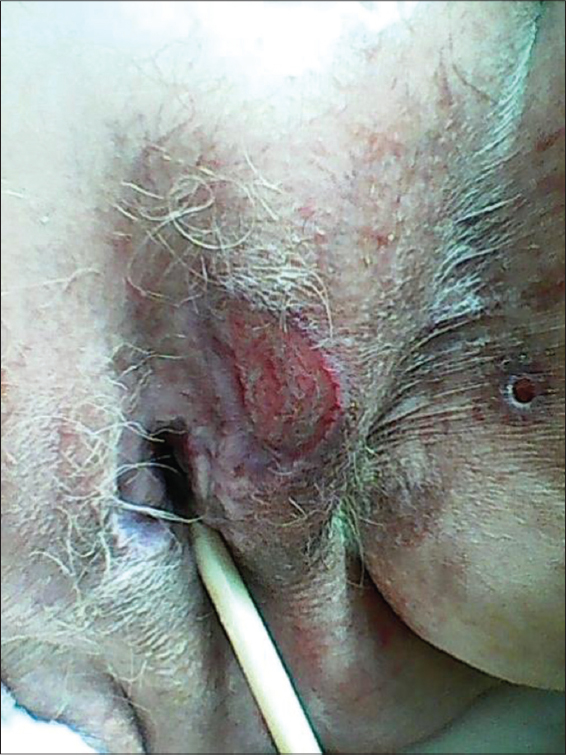|
Get Citation
|
|
|
Eleni K. Giant vulvar ulcers in the course of adult onset cyclic neutropenia. Our Dermatol Online. 2018;9(3):337-338. |
|
|
Download citation file:
|
Giant vulvar ulcers in the course of adult onset cyclic neutropenia
Klimi Eleni
Department of Dermatology, Thriassio General Hospital, Magula, Athens, Greece
Corresponding author: Dr. Klimi Eleni, E-mail: eklimi2018@gmail.com
DOI:10.7241/ourd.20183.30
Submission: 29.11.2017; Acceptance: 24.02.2017
Sir,
Genital ulcers may be associated with a variety of clinical disorders such as infectious conditions (streptococcal, staphylococcal infections), syphilis, immune disorders such as lupus erythematosus or scleroderma as well as tumors (squamous cell carcinoma etc). Other conditions such as Behcet or Crohn disease have been associated with genital ulcers.
A 73 year old female was admitted to the Internal Medicine Unit of our hospital for fever, malaise, fatigue that started a week before admission. She complained of lesions on her genitalia that provoked difficulty in urination and reported similar episodes for which she had been hospitalized in a Gynecology Departement but no specific diagnosis has been made. On admission she had fever 39 Celsius and the skin examination revealed two giant ulcers on both right and left inner side of the thighs with raised erythematous sharp demarcated borders and purulent center, as well post -inflammatory healing lesions on the lower part of the abdomen (Fig. 1).
The day of the admission WBC count was 900/mm3, with neutrophils count 400/mm3 with Hgb7,6gr/dl and Hct24,7%. Because of the fever a broad spectrum antibiotic combination was started associating ceftriaxone and aminoside. The WBC count had gradually restored to normal with WBC 1900/mm3 and neytrophils 900/mm3 the 3rd day of her hospitalization and WBC 2500/mm3, RBC 4120000M/µl, Hgb9,1gr/dl and Hct 28,7% the sixth day of her hospitalization. Bone marrow examination was performed and proved normal apart a focal increase of lymphocytes. Differential diagnosis of the genital ulcers include infectious diseases, such as syphilis, neoplastic disorders, Chrohn disease, Behcet disease and other. Serology of syphilis, Herpes 1 and 2, HIV 1 AND 2, Ebstein Barr, Cytomegalovirus, Parvovirus B19 were performed and were negative. Hemocultures taken during the feblile period yielded no bacteria or fungus A biopsy taken from the borders of the ulcer found non specific inflammation and no signs of vasculitis,therefore eliminating Behcet disease. Although no symptoms from the digestive tract were present a colonoscopy was performed. This revealed an ulcer in the terminal colon and a biopsy had been taken. The findings were similar with that of the skin biopsy showing non specific inflammation and no signs of vasculitis, enabling to exclude the diagnosis of Chrohn disease. The hematological findings, the decrease in the total WBC count and neutrophils, the progressive restoration to their normal levels within six days, the increase of lymphocytes in the bone marrow and the same repeated episodes in the past confirm the diagnosis of adult -onset neutropenia.
Cyclic neutropenia is a rare benign hematological disorder of very low frequency of 1:1000000 one in one million in the general population [1]. Decrease of white blood cell and neutrophil count occur at monthly intervals five or six times a year with restoration to normal levels within a week. Two types of the disease have been described one occurring in children with more severe course and a milder one in adulthood. Pathogenesis of the disease involves reduced neutrophil production due to accelerated apoptosis of neutrophil precursors. Most patients with cyclic neutropenia experience oral ulcerations, gingivitis, lymphadenopathy, pharyngitis, tonsillitis, sinusitis otitis media as well as skin infections [1,2]. The disease has a chronic course although spontaneous remissions have been described. Diagnosis is based on past medical history, on serial measurements of the absolute neutrophil count and on clinical findings. Treatment consists of administering antibiotics and G-CSF (granulocyte-colony stimulating factor) which reduces the duration of the neutropenic episodes as well as the risk of bacterial infection and improves quality of life.
Although adult onset cyclic neutropenia is a rare clinical condition the presence of genital ulcerations associated with fever should alert the physician towards this rare disorder in order to recognize it in time and avoid infectious complications such as bacterial or even fungal infections during the neutropenic phases. A thorough and detailed past medical history should accompany a meticulous clinical examination.
CONSENT
The examination of the patient was conducted according to the Declaration of Helsinki principles.
REFERENCES
1. Mansoor MS, Khan MB. A case of cyclic neutropenia in adults. J Pak Assoc. 2012;62:289-90.
2. Keshwara K, Zanganah Y. Cyclic neutropenia. Br Dent J. 2011;210:197-8.
Notes
Source of Support: Nil
Conflict of Interest: None declared.

Comments are closed.